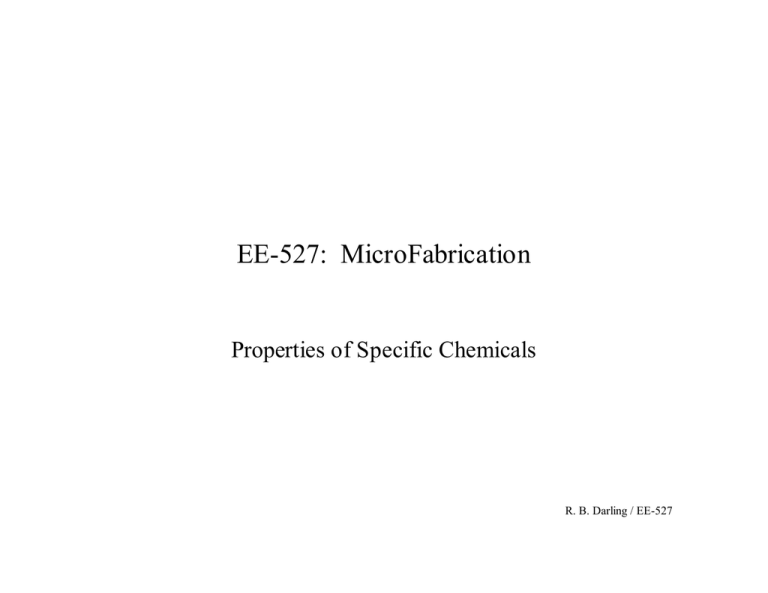EE-527: MicroFabrication Properties of Specific Chemicals R. B. Darling / EE-527
advertisement

EE-527: MicroFabrication Properties of Specific Chemicals R. B. Darling / EE-527 Be Careful and Know Some Chemistry – “On April 16, 1947, 2200 tons of ammonium nitrate [fertilizer] was stored on board the S. S. Grandcamp along with 1500 tons of fuel oil. While docked at Texas City, Texas, a fire was detected in the hold. An order was given to close hatches and to apply steam throughout the hold. Under these conditions, the fire could not extinguish. Instead, the internal pressure built up at an uncontrollable rate, causing the cargo vessel to explode. Six hundred people were killed and another 3500 were injured. The property damage was comparable to that experienced during a major wartime bombing incident. The total property loss was estimated as $33 million based upon 1947 costs.” – Eugene Meyer, The Chemistry of Hazardous Materials, 2nd ed. R. B. Darling / EE-527 Sulfuric Acid (H2SO4) - 1 – – – – – – most commonly used industrial chemical also called “oil of vitriol” colorless, oily, syrupy liquid, specific gravity = 1.84 standard reagent concentration is 98 %, yellow bottle cap NFPA704M code = 3-0-2-W “fuming sulfuric acid” or “oleum” has additional SO3 dissolved into solution; actually is H2S2O7, disulfuric acid • primary hazards: – when dissolved into water, H2SO4 liberates considerable heat • 20 kcal/mol = 1570.9 J/cm3 – H2SO4 is a strong acid, but only the first proton dissociates completely; second proton has Ki = 10-2 – always add acid to water to avoid spattering R. B. Darling / EE-527 Sulfuric Acid (H2SO4) - 2 • primary hazards: – concentrated H2SO4 has a great affinity for H2O: hygroscopic – concentrated H2SO4 will dehydrate sugars, starches, and cellulose – acid burns to skin dehydrate the tissue with localized evolution of heat. skin becomes charred, like burnt wood – concentrated H2SO4 dehydrates concentrated HClO4 (perchloric acid). The two can explosively decompose and must be stored in separate cabinets. – concentrated H2SO4 can react to form hazardous compounds • chlorine containing oxidizers will react explosively • will decompose salts into other acids – 2NaF + H2SO4 → Na2SO4 + 2HF • may produce toxic gases, e.g. Br2, I2, SO2, CO, COS, H2S • concentrated H2SO4 will oxidize carbon, lead, and copper R. B. Darling / EE-527 Nitric Acid (HNO3) - 1 – second most commonly used industrial chemical – colorless liquid, often reddish-brown from dissolved NO2 • light exposure produces: 4HNO3 → 4NO2 + 2H2O + O2 – – – – also called “aqua fortis” in art engraving excess dissolved NO2 produces “fuming” nitric acid standard reagent concentration is 68-70 %, red bottle cap NFPA704M code = 3-0-0-OXY R. B. Darling / EE-527 Nitric Acid (HNO3) - 2 • primary hazards: – reacts with metals and nonmetals, releases NO and/or NO2 – concentrated HNO3 will spontaneously ignite wood, cellulose products, and many organic materials such as turpentine, acetic acid, acetone, ethyl alcohol, nitrobenzene, and aniline – concentrated HNO3 oxidizes proteins • produces xanthoproteic acid (yellow colored, slow-healing wound) – concentrated HNO3 acts as both an acid and an oxidizer!! R. B. Darling / EE-527 Hydrochloric Acid (HCl) – pure HCl is a strong-smelling, colorless gas • TLV = 5 ppm, exposure to > 1500 ppm is usually fatal • extremely soluble in H2O – – – – technical grade HCl is slightly yellow due to Fe++ impurities also know as “muriatic acid” standard reagent concentration is 37 %, blue bottle cap NFPA704M code = 3-0-0 • primary hazards: – corrosive effect on metals – vapor toxicity: • • • • 1-5 ppm = limit of odor 35 ppm = irritation of throat 50 ppm = barely tolerable 1000 ppm = fatal via lung edema R. B. Darling / EE-527 Aqua Regia – – – – mixture of 3 parts conc. HCl and 1 part conc. HNO3 also called “nitrohydrochloric acid” very potent oxidizing agent useful for dissolving Au and Pt R. B. Darling / EE-527 Perchloric Acid (HClO4) – – – – – strongest of all of the common acids anhydrous form is unstable standard reagent concentration is 72 % NFPA704M code = 3-0-3-OXY must be used and stored in specially designed facilities • primary hazards: – concentrated HClO4 when heated to 92C explodes • 4HClO4 → 2Cl2 + 7O2 + 2H2O – concentrated HClO4 ignites or explodes with cellulose materials and most organic compounds – treated differently following the 1940’s Los Angeles explosion caused by its reaction with aniline R. B. Darling / EE-527 Hydrofluoric Acid (HF) - 1 – – – – – pure HF is a colorless gas above 20C, TLV = 2.5 ppm similar in reactivity to H2SO4 a strong dehydrating agent has a high affinity for water (hygroscopic) dissolved in H2O it becomes a weak acid (it partially dissociates) • BUT IT IS STILL EXTREMELY DANGEROUS!! – standard reagent concentration is 49 % – NFPA704M code = 4-0-0 – HF dissolves glasses: • CaSiO3 + 6HF → CaF2 + SiF4 + 3H2O • SiO2 + 4HF → SiF4 + 2H2O – concentrated HF must be stored in polypropylene containers!! – commercially used for etching glass R. B. Darling / EE-527 Hydrofluoric Acid (HF) - 2 • primary hazards: – HF vapor produces edema of the lungs and can permanently damage the cornea – HF is extremely dangerous to skin contact, the worst of all acids in terms of damage to tissue, can produce very severe, painful burns – HF has a slight anesthetizing effect, pain is often not noticed until the acid has penetrated a large distance into tissue, often down into bone material where it reacts with Ca and Mg to form fluorides – because of small size of molecule, HF dissolves easily though pores of skin and cell membranes, and also through many plastics – use only Trionic gloves when dealing with HF!! – at present there exists no real remedy for HF burns • some suggest an ointment of 3 oz. magnesium oxide, 4 oz. heavy mineral oil, and 11 oz. white vaseline is helpful R. B. Darling / EE-527 Buffered Oxide Etch (BOE) – a solution of HF and NH4F, usually 10:1 ratio by volume – NH4F is a solid crystal, but dissolved in H2O, it produces some HF and fluorine ion – industry standard solution for etching SiO2 – NH4F provides buffering of the fluoride ion, as SiO2 etching procedes, the NH4F replenishes the fluoride ion that is consumed in the creation of SiF4 – NFPA704M code = 4-0-0 • primary hazards: – the same as for hydrofluoric acid, HF – use only Trionic gloves when dealing with BOE!! R. B. Darling / EE-527 Phosphoric Acid (H3PO4) – phosphorous forms 8 different acids; H3PO4 is the most common – clear, odorless, sparkling liquid or transparent solid – phosphorous anhydride is a strong dehydrator and has a great affinity for water. Dissolved in water it produces phosphoric acid: • P4O10 + 6H2O → 4H3PO4 – standard reagent concentration is 85 %, white bottle cap – NFPA704M code = 2-0-0 • primary hazards: – concentrated H3PO4 liberates considerable heat when diluted with water; always add the acid to the water to avoid spattering – concentrated H3PO4 can cause severe skin burns, but it is generally the least hazardous of the strong mineral acids R. B. Darling / EE-527 Acetic Acid (CH3COOH) – most common organic acid – causes the sour taste and odor of vinegar (typ. 3-6 % acetic acid) – “glacial” acetic acid is about 99.5 % acetic acid, derived from the decomposition of acetylene, used in photography – standard reagent concentration is 99 %, brown bottle cap – NFPA704M code = 2-2-1 • primary hazards: – primary hazard is its corrosiveness – vapors are harmful, TLV = 10 ppm – CH3COOH freezes at 17C, and like water, expands upon freezing • glass bottles must be protected against temperatures below 17C – CH3COOH will burn, but the autoignition temperature is 426C and is generally unlikely without the presence of an ignition source R. B. Darling / EE-527 Sodium Hydroxide (NaOH) - 1 – most common alkali – also called “lye” or “caustic soda” – produced by electrolysis of brine • 2NaCl + 2H2O → 2NaOH + H2 + Cl2 – at room temp., NaOH is a white solid, usually pellets or powder – very hygroscopic – weak solutions have a bitter or caustic taste, and a slippery or soapy feeling, typical of all alkalis – like all alkalis, it can destroy or burn tissues, leaving serious wounds that heal very slowly – standard reagent concentration is 97 % – NFPA704M code = 3-0-1 R. B. Darling / EE-527 Sodium Hydroxide (NaOH) - 2 • primary hazards: – can cause extremely severe burns to the skin • treat with 1 % acetic acid solution or common household vinegar • tissues have no natural defense to strong bases, so tissue damage can be greater than that of a strong acid – strong acids create impermeable damage zone with limits spread – strong bases do not create this reaction and can diffuse much farther – can cause extremely severe burns to the cornea • treat with 1 % boric acid to neutralize after several minutes of irrigation with water – nonflammable by itself, but can trigger the ignition of other materials – very exothermic upon dissolving in H2O • 10 kcal/mole • hot enough to ignite or melt some materials R. B. Darling / EE-527 Potassium Hydroxide (KOH) – – – – – – – also called “potash” or “caustic potash” very similar to NaOH considered a slightly stronger base at room temp., NaOH is a white solid, usually pellets or powder very hygroscopic standard reagent concentration is 97 % NFPA704M code = 3-0-1 • primary hazards: – very similar to NaOH R. B. Darling / EE-527 Ammonium Hydroxide (NH4OH) – – – – – created by dissolving NH3 into H2O NH3 is very soluble in H2O, forms a weak base (partially ionizes) neutralizes acids, but is generally unreactive with most metals standard reagent concentration is 30 %, green bottle cap NFPA704M code = 3-1-0 • primary hazards: – concentrated NH4OH will burn skin – NH3 vapors are harmful • TLV = 50 ppm • moderately toxic, strong irritant to skin, eyes, and mucus membranes R. B. Darling / EE-527 Hydrogen Peroxide (H2O2) – resembles water, but with a slightly sharp odor – a very strong oxidizer – inherently unstable, decomposes from sunlight or UV radiation • 2H2O2 → 2H2O + O2 • typically lasts only a few months under refrigeration – standard reagent concentration is 30 %, white bottle cap – NFPA704M code = 2-0-1-OXY • primary hazards: – decomposes violently at 144C – readily provides oxygen in redox reactions • can cause spontaneous ignition of combustible materials when > 50 % • greatly speeds up many reactions, turning some toward explosions – can cause severe skin burns or bleaching • drug store hydrogen peroxide is only 1-3 % R. B. Darling / EE-527


